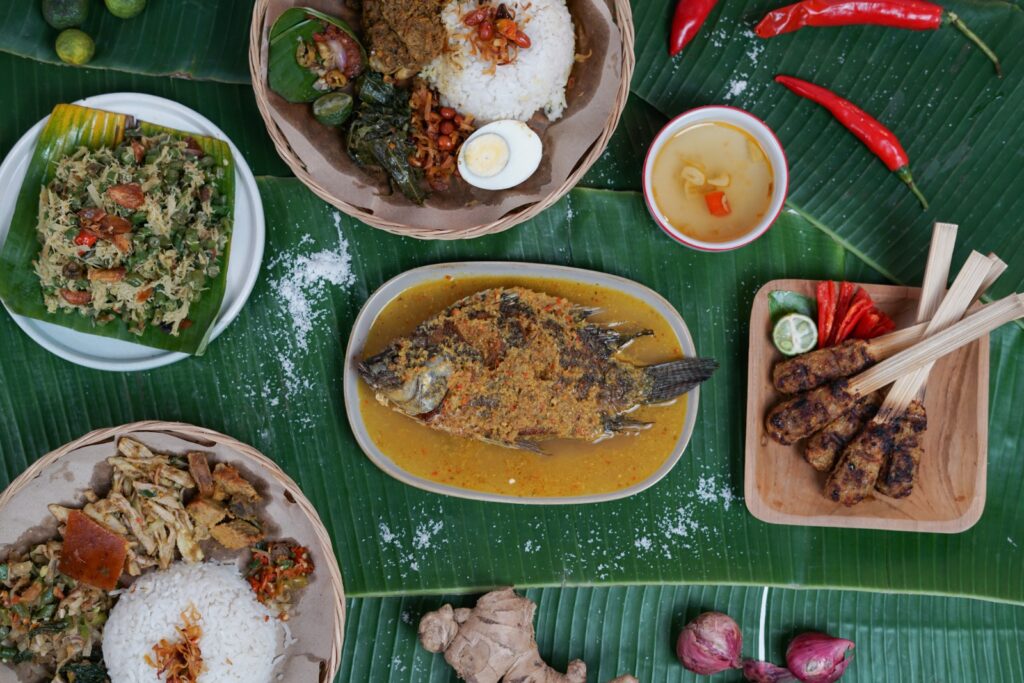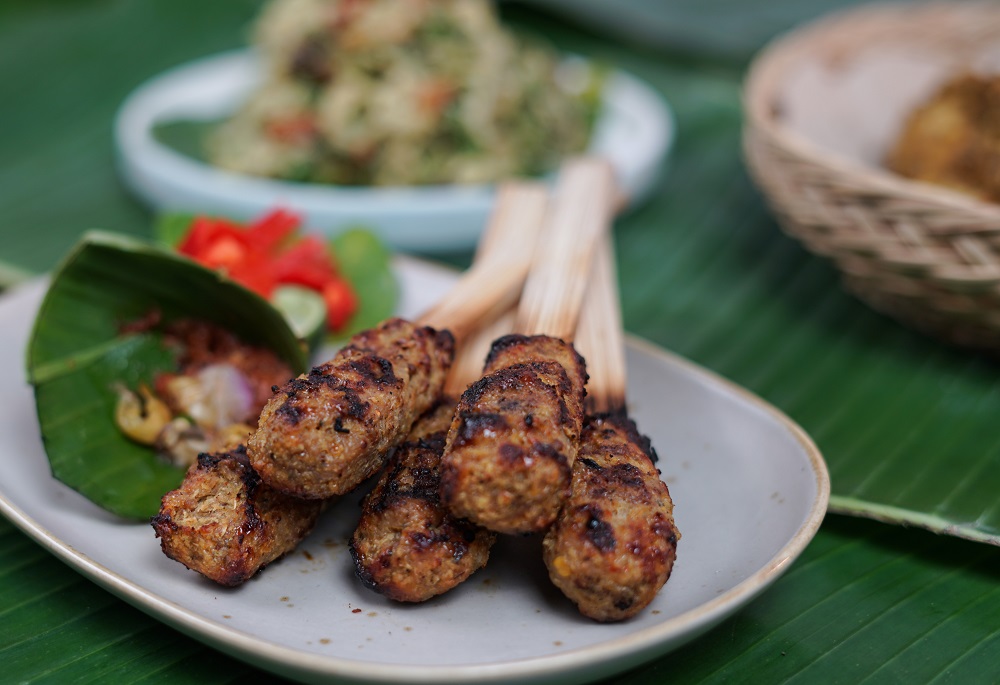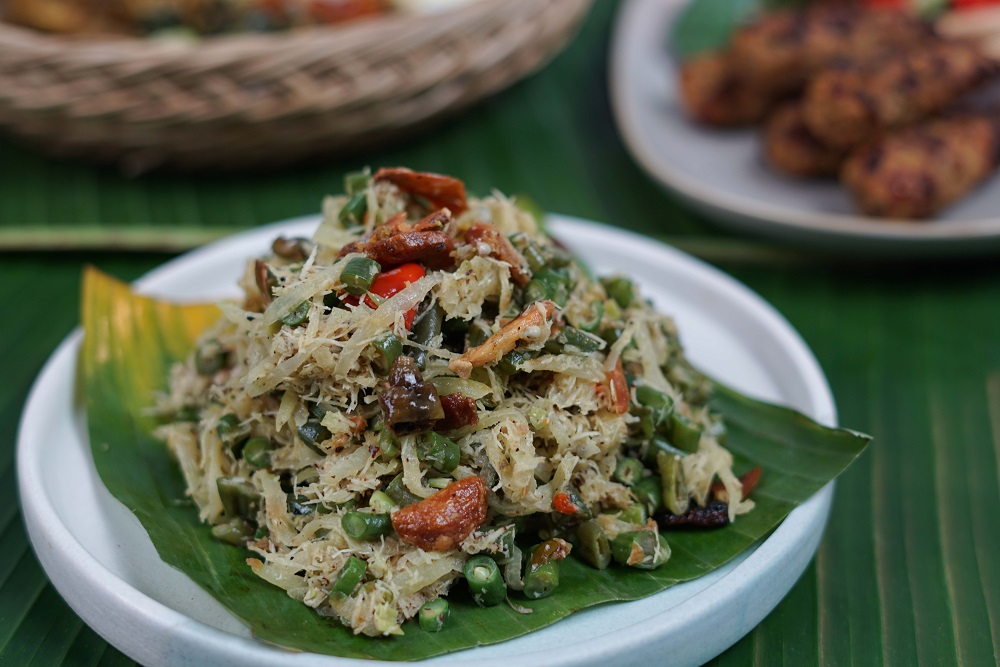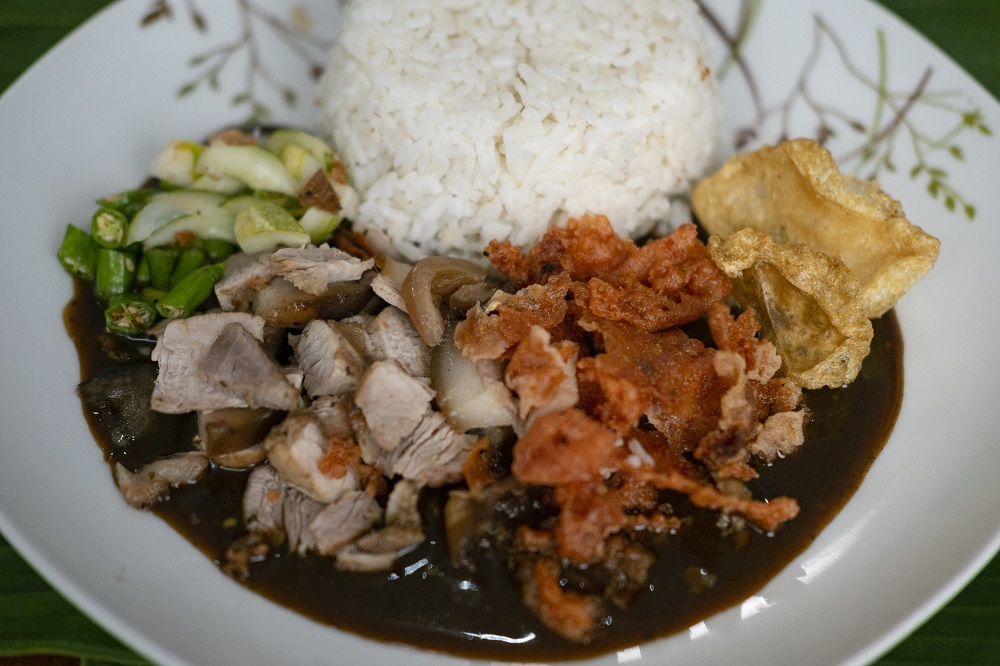
An aspect of Balinese culture that continues to captivate visitors and locals alike is its culinary legacy, a testament to the island’s rich tapestry of traditions shaped by centuries of trade and migration. The authentic Balinese cuisine offers a glimpse into the island’s soul, where each dish tells a story of heritage, community, and the vibrant spirit of its people. Embark on a journey into the culinary gems of Bali and discover the history of its indigenous gastronomy that has indulged palates for generations.
Ayam Betutu | Babi Guling | Sate Lilit | Lawar | Ikan Nyat-Nyat | Siobak | Serombotan
Ayam Betutu

Poultry has long been a part of the cuisine of the ancient Balinese kingdoms. During that era, visiting officials were often served chicken, making it a valuable delicacy. And at the heart of Balinese cuisine lies Ayam Betutu (‘betutu’ chicken), a timeless delicacy steeped in tradition that is also served in significant ceremonies including religious rituals such as odalan, otonan, and weddings.
Commercialised in the 1970s when it was introduced by a Balinese woman from Gianyar named Ni Wayan Tempeh, famously known as Men Tempeh, this roasted chicken dish embodies the essence of Balinese flavours, infused with rich and fragrant betutu spices. Men Tempeh and her husband created an ayam betutu ‘warung’, where she created the recipe for the legendary dish. From its humble origins in Gianyar to its now iconic status, the influences of its cooking method can be traced back to the ancient Majapahit era.
In the 16th century, when Islamic influences entered Java, many Majapahit people who were Hindus migrated to Bali and, along with their Majapahit culture, brought with them their culinary traditions. Utilising the pit-burning method from the Majapahit, the process of making ayam betutu includes seasoning its surface to its inside cavity, then covering it with areca nut leaves, before being burrowed in a hole underground that has been covered with hot stones and burning husks.
The name ‘betutu’ is a combination of the word ‘be’ meaning meat and ‘tunu’ meaning roasted or grilled. Therefore, the word betutu loosely translates to roasted meat. The unique flavour of this dish mainly comes from base genep, a spice paste that is a quintessential component in Balinese cuisine, consisting of several spices. The spices include aromatic ginger, ginger, galangal, turmeric, shallots, garlic, chilli, coriander, pepper, candlenuts, nutmeg, cumin, cardamom, orange, and more, which together make the distinct complex, bold and sharp flavour the paste is known for.
Traditionally lasting overnight or up to three days to cook, this traditional way is done to ensure the meat is perfectly seasoned, soft, easily separates from the bone, and exudes a distinctive grilled aroma. However, more modern time-efficient methods have been introduced including using steam or pressure cookers, then baking it in the oven or using other modern grill appliances. Another popular alternative to chicken is using duck instead, which is known as bebek betutu.
Babi Guling

Standing as the indisputable icon of Balinese cuisine is, Babi Guling or suckling pig. Its cultural significance has resulted in this native dish being listed as a UNESCO intangible cultural heritage of Indonesia since 2011.
The history of babi guling dates back centuries as pork has long been a source of animal protein for the people of the archipelago. Back then, in areas where Islam had not yet entered, pigs were the most efficient deviation from grain to meat, becoming the primary source of meat.
Whilst pork is considered haram to be consumed by Muslims, it is one of the main proteins that the Balinese Hindus consume, namely babi guling, which is one of the mandatory foods served during religious Hindu celebrations as an offering, as a form of gratitude to God, as a symbol asking for blessings and to bring prosperity.
This Balinese delicacy is cooked whole. Firstly, the suckling pig that has been slaughtered is doused with hot water to ensure the skin is clean. Then, the pig is gutted, cleaned and skewered. This is followed by stuffing spices including base genep and others into the pig’s stomach.
The pork belly is then sewn together to prevent spices from spilling out. Once this is done, the pig is roasted over a fire pit by rotating it to ensure it is evenly cooked until the skin is crispy with a reddish yellow. Food connoisseurs can find babi guling anywhere, from local eateries and legendary restaurants to the lavish buffets and dining venues of luxurious hotels and resorts.
Sate Lilit

One of Indonesia’s most renowned staple dishes is sate (satay), which itself comes in an array of variations. Bali also has its very own satay native to the island called Sate Lilit or Satay Lilit. Sate Lilit originated from the Klungkung Regency and was formerly served only during religious ceremonies but has now become a daily dish easily found anywhere on the island, ranging from street food vendors to restaurants.
In the olden days, sate lilit was authentically made from fish or pork because the Balinese prefer them over other meats such as beef which the Balinese Hindus seldom consume. However, to accommodate larger consumers that do not eat pork, sate lilit is also made using chicken and beef nowadays.
Sate lilit is made from minced fish, pork, chicken or beef, combined with grated coconut, thick coconut milk, lemon juice, shallots, pepper and the Balinese base genep spices that give it that distinctive yellow appearance. It is then wrapped around bamboo, sugarcane or lemongrass sticks before it is charcoal-grilled. Sate lilit differs from other satays which are skewered using narrow and sharp skewers, sate lilit’s flat and wide bamboo skewer provides a wider surface for the minced meat to stick and settle, hence, the term lilit which means “to wrap around” in Indonesian.
There’s a philosophy behind sate lilit, said to symbolise unity in Balinese people. Apart from that, sate lilit is also a symbol of masculinity because back then only men were allowed to make them. From making the mixture to the baking process, if a man cannot complete this task, their masculinity will be questioned.
Culturally, sate lilit is one of the essential dishes included specifically during Galungan ceremonies, where there are nine types of satays named sate panawa sangan. These satay variations come in different shapes as representations of the weapons of the Dewata Nawa Sangha (the Nine Gods), where sate lilit is a symbol of the Hindu God Brahma’s weapon in the form of a mace.
Lawar

One of the most typical Balinese dishes is Lawar, a traditional everyday dish that can be found practically anywhere on the island ranging from local households and eateries to restaurants and hotels.
Lawar is a dish that comprises a combination of vegetables, various traditional Balinese spices, grated coconut, shrimp paste and minced meat. This dish typically has a sweet, sour, spicy and savoury flavour, making it a delectable dish with a distinct taste.
What makes Lawar such a unique Balinese food is its use of animal blood as part of the ingredients, where the blood is usually half-cooked and mixed in with certain spices to enhance the flavours of the dish. There are, however, many variations of Lawar depending on the type of meat and vegetables used. Several examples include Lawar Nangka if jackfruit is used as the main ingredient, and Lawar Putih if it does not use animal blood.
Lawar from different areas of Bali can also vary, for example, typical Lawar from Tabanan and those from Karangasem have different flavours. In the Badung and Gianyar Regencies, they use long beans for the vegetables, while the ones from the Buleleng Regency commonly use young jackfruit and papaya leaves.
Although there are no written records of its history, Lawar has played a vital role in Balinese culture for centuries, passed down through history from generation to generation. Believed to have existed since ancient days, Lawar is used as part of various traditional ceremonies, religious rituals, food offerings and celebrations, much like many of Bali’s staple dishes. According to Balinese people, Lawar symbolises harmony and balance: the red blood represents Dewa Brahma, the white coconut represents the Dewa Iswara, and the black shrimp paste represents Dewa Wisnu.
As an important aspect of Balinese culinary culture, lawar stands to this day to be a popular authentic Balinese food appreciated by locals and tourists alike, reflecting the richness and cultural diversity of the island.
Ikan Nyat Nyat

In the Kintamani area, one of the most popular tourist sightseeing spots is Lake Batur, and fitting to its setting, one signature dish from the region hails from the waters of the vast lake – Ikan Mujair Nyat-Nyat, a seafood dish that uses ikan mujair or tilapia fish. Ikan mujair, or as the Balinese call them, ‘be jair’, are commonly found in Lake Batur, where you’ll see many local fish farmers harvesting mujair fish ponds.
This local Kintamani delicacy is cooked by frying the fish before preparing it in a process called the ‘nyat nyat’, a term derived from the Balinese word ‘nyat’, which can be translated as ‘reducing’. Nyat-nyat is a typical Balinese cooking method where the ingredients are cooked with water and spices until little water remains, hence, its aforementioned name. This dish has become a culinary staple in Bali, one reason domestic and foreign visitors come to Kintamani.
Trying out this dish directly in Kintamani ensures freshness as the fish is taken directly from Lake Batur. Preparing this dish requires several kinds of spices, including shallots, garlic, red chillies, candlenuts, and base genep, a basic Balinese ingredient that comprises 15 different spices. All of the ingredients are then ground together with seasonings such as salt and lime before being cooked in the nyat-nyat method together with the tilapia fish that has already been fried.
Siobak

North Bali holds a significant history, especially since the old Singaraja port was the primary entryway to Bali during the Dutch colonial era. This has resulted in Singaraja being a melting pot of culture, having one of the most diverse populations in Bali where you’ll find evidence of in-migration influences including its cuisine.
One of the signature culinary staples originating from Singaraja is Siobak, a traditional Balinese pork dish in Singaraja that is evidence of Chinese acculturation in the region. As pork is one of the main proteins common in Balinese cuisine, it’s not hard to find siobak anywhere on the island. Siobak is distinct for its thick seasoning, which features a sweet taste rich in spices and is synonymous with all Balinese dishes.
If you’re ever in Singaraja, one legendary establishment famed for its siobak is Warung Siobak Babi Khe Lok, which has been around since 1963. This Balinese cuisine incorporates a variety of ingredients including spices such as garlic, chilli powder, ngohiong (Chinese five-spice powder), salt, brown sugar, lime, vinegar, ancgiu (Chinese cooking wine), and most importantly tauco (preserved fermented yellow soybean paste).
A serving of siobak consists of pork innards, pork belly, pork skin crackers, and acar (pickled vegetables), and in true Indonesian fashion is best enjoyed with a plate of warm rice. Although it uses pork innards, proper marinating and cooking process will remove the ‘fishy’ odour.
Serombotan

Travelling to the southeast of Bali, the Klungkung Regency has its own delicacy most likely unfamiliar to most outsiders: Serombotan. During its golden era, the Klungkung Regency was the centre of the largest kingdom in Bali and a typical royal cuisine that is still part of the culture of the local community is serombotan.
A type of side dish that can be likened to a gado-gado, serombotan consists of several types of vegetables, nuts and spices, commonly enjoyed as an accompaniment to rice. For those travelling to Klungkung, you’ll easily find serombotan in ‘warungs’, street food stalls, and Pasar Seni Klungkung (Klungkung Art Centre).
However, it is not limited to Klungkung as it can now be found in other parts of the island. You’ll find this Balinese cuisine in local street markets across Bali, though they probably won’t be as authentic as the ones you’ll find in Klungkung because even if the recipe is the same, still, it’s the hands that make the dish.
As a vegetable-based delicacy, serombotan is a dish that will certainly entice vegetarians but it also has a lot of health benefits as it is high in fibre and iron. The vegetables used to make serombotan include kale, spinach, green beans, bean sprouts, long beans, kecipir (winged beans), pare (bitter melon, and eggplant. These vegetables, apart from the eggplant, are boiled individually and once cooled, chopped into pieces and mixed in with the sauce. The ingredients also include nuts such as peanuts, pigeon peas, red beans, and mung beans, while two types of ‘sambal’ complete the dish, namely ‘sambal kelapa’ and ‘sambal koples’.
One of the legendary places to find serombotan is a stall owned by Ni Wayan Suparmi at the Semarapura Art Market in Klunkgung, where she sells serombotan with three types of rice, including white rice, sela rice (cassava), and corn rice.

![Best Restaurants in Canggu [2024]: A NOW! Bali Guide Best Restaurants in Canggu [2024]: A NOW! Bali Guide](https://www.nowbali.co.id/wp-content/uploads/2024/05/Best-Restaurants-in-Canggu-MASON-1-1024x683.jpg)

